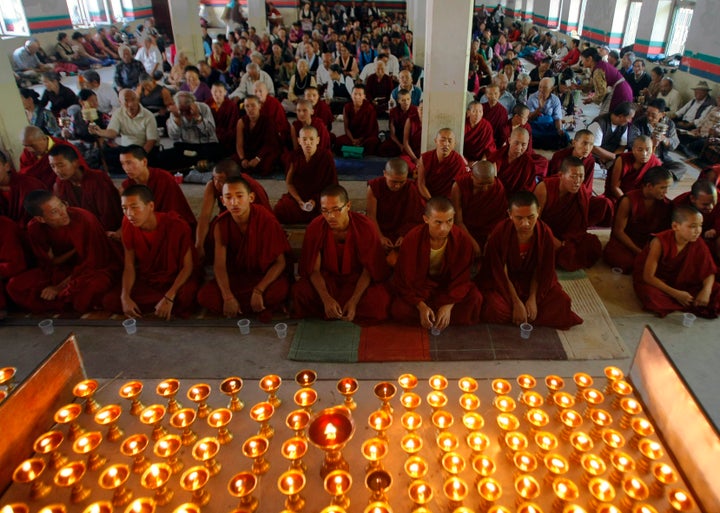
With TIME magazine hoisting the self-immolations in Tibet as the top most underreported story of 2011, just one day after the 12th Tibetan set himself on fire, suddenly there is a window of attention on this disturbing trend. Many Tibet activists are hailing these young men and women as heroes while the Chinese government vilifies them as extremists, even going so far as to call them terrorists.
Dr. Robert Barnett, a professor of Modern Tibetan Studies at Columbia University, offers some intriguing analysis as to the influences around these events, and especially about how a Chinese propaganda film aimed at winning Tibetans towards the state may have had unintended consequences.
Before a 20-something monk named Tapey set fire to himself in 2009, self-immolation was unheard of as a form of public political protest. Some Tibet activists like to suggest that Tibetans in Tibet have been inspired by the Tunisian vegetable merchant, Mohamed Bouazizi, whose act of self-immolation inspired protests that led to the toppling of the Tunisian government. But the fact is that Tibet is arguably one of the most information-deprived societies on earth, and this piece of news even circumvented well-informed people in Western democracies who had access to a plethora of information channels.
Barnett thinks that it is unlikely that these events in Tibet are related to the similar events in Tunisia or Vietnam. "I don't think that people in Tibet are doing this strategically. People aren't sitting down saying, "How can we get attention?" I think it comes from a much greater source of frustration and a sense that there is nothing left that they can do."
He suggests that to understand what is happening in Tibet, we look at the immediate cultural context. All of those who have self-immolated have been young -- almost all of them under 30. All are monks, nuns, or former monks.
"This means that they were brought up long after the cultural revolution," says Barnett. "They have been brought up in a divided period of Tibet when they have this huge amount of rhetoric from the Chinese side, and indeed from many Westerners, that they're living in a country that is becoming more free, that has more technological and economic progress, and where there is more openness. But actually, they experience the opposite, especially if they become monks and nuns. The tension that they have to live under, the surveillance and the criticism from the state, is far more acute for the monastic community than for most other groups of Tibetans. I think that this exacerbates the feeling of a state that is against them. Also, the way that the Chinese government handled the protests in 2008 made a lot of Tibetans feel that the they are not really part of the state, that state is not really listening to them."
Says Barnett, "One of the major sources in Tibetan culture today for the practice of self-immolation, especially for those in their 20s or 30s, is not embedded deep in Buddhist history but is apparent in Chinese propaganda. The most famous and influential of all modern films made by the Chinese government to propagate their claim to Tibet was Red River Valley, (Ch. Hóng hégŭ). This 1997 film was little seen outside the mainland, and depicts Tibetans bravely struggling against the British invasion around the turn of the century. Towards the end of Red River Valley, the Tibetan hero wins the battle for the Tibetans by setting himself on fire while taking out the British battalion.
The last shot of the film is the cigarette lighter used by the hero to set himself on fire transposed over a prayer wheel, a symbol of Buddhist religious faith. The juxtaposition was not lost on Chinese propagandists, and it seems is also not lost on modern Tibetans.
Barnett says that all Tibetans of school age were made to go and watch Red River Valley as part of the patriotic education campaign across China at the time. "I'm not saying that this film is related to the current events, but we can say that in contemporary Communist culture there is a glorification of these kinds of acts. In Chinese films it's done for the state or for Communism, but in Tibet it's applying it in a particular Tibetan Buddhist context where it has much greater meaning because of the history of Buddhist admiration of the renunciation of oneself for a greater good."
Recently, China's state mouthpiece Xinhua quoted Li Decheng, director of the Institute for Religious Studies under the China Tibetology Research Center, as stating that these acts of self-immolation "seriously violated the fundamental precept of Buddhism." Quoting Buddhist scriptures, Li said killing oneself or others, or instigating such killing, constitute "grave sins," and those who commit such sins "must be expelled from the Buddhist circle, disqualified as a monk or nun and condemned to hell."
Barnett offers a different view. "As a religious practice this isn't deeply new. You see references to it when you see the phrase 'using one's body as an offering' or 'giving one's body as a butterlamp'. This is an old Tibetan religious phrase that does exist in the texts and is referred to centuries ago as having been done in the past. It probably relates to the Lotus Sutra, which describes this practice as signifying that one has no attachment to the body. So there is a sense in which this is a Buddhist practice but not as a political protest in Tibet."
The fact these these young men and women are monks and nuns or former monks or nuns, Barnett feels, is deeply significant. "They may not have read the actual texts in which these things are described. It's probably not as literal as that. But they're drawing on a general idea that is prevalent in Tibetan Buddhist culture about the notion, in the Mahayana tradition, of giving yourself up for a greater ideal. So there's a very important distinction here between the idea in Buddhism, especially Theravada Buddhism, that you should strive not to do violence to yourself because it will damage your future rebirths, in tension with the idea that you should be giving up everything to serve a larger ideal, the community, or more likely the religion. This ideal seems to be very strong in the thinking behind these acts."
On December 6th, Tenzin Phuntsog, another former monk, succumbed to the terrible injuries from setting himself on fire. As no independent media have access to the plateau, we are left to try as best we can to uncover the layers of truth behind actions such as his. Many of those who have done the same called for the return of the Dalai Lama and for Tibetan independence before being engulfed in flames. But even these apparently simple demands disguise a complexity of meaning. "These images and terrible tragedies are entering a marketplace of ideas and agendas where people are competing for ownership," says Barnett. "It's generally well-motivated, but the market-place is a dangerous place. Which voice becomes dominant in an Internet world is always uncertain."
One thing that is almost certain, however, is that the irony of the Chinese state becoming the target of its own anti-imperialist propaganda will be lost on most.
